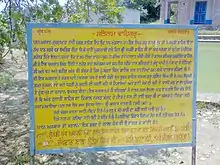Lakhi Jungle
Lakhi Jungle is a village in the district of Bathinda in Punjab, India. It is situated 15 km from the city of Bathinda (near Goniana), on the way to Muktsar.[1] The historic Gurdwara Lakhi Jungle Sahib is located on the outskirts of the village.
History

A jungle formed in this area due to the shifting course of the Sutlej river.[2] A Bhatti chief, named Rana Lakhi, is said to have settled in the area of the Lakhi Jungle around the turn of the millennium between the 10th and 11th centuries.[2] The ninth Sikh Guru, Guru Teg Bahadur and tenth Sikh Guru, Guru Gobind Singh visited this place.[3] During the time period of Guru Gobind Singh and later, the area of the later Firozpur division was covered by a dense forest which stretched from Bathinda to Kotkapura.[4][5] In the 18th century, the Sikhs used the surrounding jungle (from which the village takes its name) as a hideout from persecution by the Mughal Empire and the Duranni Empire.[6] During Ahmad Shah Durrani's seventh invasion of India between 1764–65, the Sikhs used the jungle as a hideout.[7] The area was known for its horse traders, which may have partly attracted Sikh refugees to the area.[8] Historian Muzaffar Alam notes that the Sikhs of the 18th century used the jungle as a place of safety from state oppression and as a staging ground to launch attacks on plundering neighbouring villages and extracting tribute from zamindars.[9] Abdus-samad Khan crushed a rebellion by local Bhatti zamindars of the Lakhi Jungle in the 18th century.[10] The area was well-renowned for horse-breeding and its oxen all the way up till the 19th century.[2] The jungle itself has mostly since been deforested.
References
- http://censusindia.gov.in/2011census/dchb/DCHB_A/03/0312_PART_A_DCHB_BATHINDA.pdf
- Gommans, Jos (2017). The Indian Frontier : Horse and Warband in the Making of Empires. Milton: Routledge. ISBN 978-1-351-36356-3. OCLC 1051140387.
According to local tradition, one of the Bhatti chiefs, Rana Lakhi, settled in the Lakhi Jungle, the extensive jungle produced by the ever shifting Sutlej, in the reign of Mahmud of Ghazni (998-1030). He subsequently became a Muslim and founded 300 villages. He also procured a great number of Iranian horses and ordered his subjects to begin horse-breeding. Other evidence also confirms the high quality of the local horse breed, a standard that was kept up by the foreign horses that staged the perennial invasions from the north-west. Sultan Balban (1266-87), being cut off from foreign sources, procured most of his cavalry horses in the Bhatti area. The whole of the eastern Punjab, but the Lakhi Jungle in particular, remained a major horse-breeding area up to the nineteenth century,
- Gandhi, Surjit Singh (2007). "Khalsa Battles Against Mughal Imperialism". History of Sikh Gurus Retold: 1606-1708 C.E. Vol. 2. Atlantic Publishers & Dist. p. 841. ISBN 9788126908585.
- Gupta, Hari Ram (1994). History of the Sikhs. New Delhi: Munshiram Manoharlal. p. 303. ISBN 81-215-0276-4. OCLC 41281752.
- Dhillon, Harish (2015). The Sikh Gurus. Hay House Publishing. ISBN 978-93-84544-45-4. OCLC 968092357.
The Guru camped in Lakhi jungle, a forest between the towns of Bhatinda and Kotkapura, for a while, and then moved on to Talwandi Sabo, where he was greeted with great warmth by Bhai Dalla, the landlord.
- Singh, Teja. (1999). A short history of the Sikhs. Volume one, 1469-1765. Singh, Ganda. (3rd ed.). Patiala: Publication Bureau, Punjabi University. ISBN 9788173800078. OCLC 235973547.
- Kohli, Surindar Singh (1993). The Sikhs and Sikhism. Atlantic Publishers and Distributors. p. 63.
- Fenech, Louis E.; McLeod, W.H. (2014). Historical Dictionary of Sikhism. Historical Dictionaries of Religions, Philosophies, and Movements Series (3rd ed.). Rowman & Littlefield. p. 189. ISBN 9781442236011.
LAKHI JUNGLE. A wasteland south of Firozpur where the Khalsa sheltered during periods of persecution in the 18th century. The sheltering likely had to do with the fact that the area was a well-known ground of horse traders.
- Environment and History. Vol. 5. White Horse Press. 1999. p. 365.
- Irvine, William (1991). "Sikhs Ravage North Punjab Repeatedly". Later Mughals. Atlantic Publishers and Distributors. p. 311.